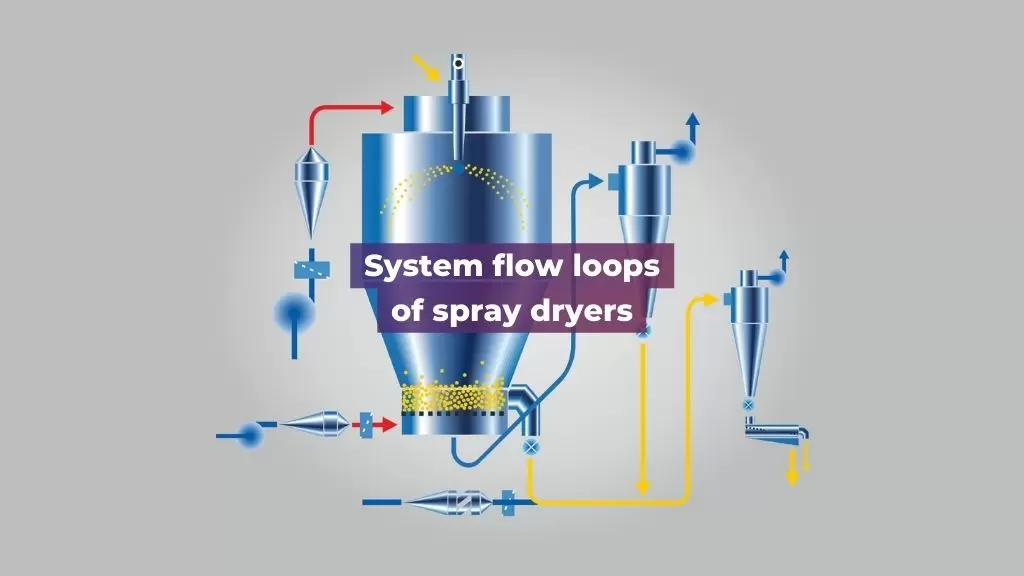Explosives and pharmaceutical products are some of the sensitive materials that undergo spray drying process. Similarly, environmental concerns too deeply influence the design and working of spray dryers. Modifications are made to the flow loop system to tackle sensitive products and reduce the environmental impact of spray drying process. Spray dryers are classified in three different types on the basis of the flow loop system:
Open cycle
In open cycle drying system air is drawn from the surrounding, heated and used as dying medium and after its utilisation it is then released to the environment. This type of system commonly used when moisture content in the feed is water.
Picture: Open Cycle Co-Current Flow System
⦁ Air suction from the surrounding⦁ Air heater
⦁ Feed
⦁ Drying chamber
⦁ Cyclone separator
⦁ Powdered product to packaging
⦁ Venturi scrubber
⦁ Scrubber tank
⦁ Exhaust duct/Vent to the environment
Closed cycle
In the closed loop cycle, the drying medium is heated and utilised to remove solvent from the feed spray; condensed further to remove moisture content and then reused again as the drying medium.The Closed Cycle system is used when moisture content is valuable or hazardous and therefore needs to recovered. Spray Dryers for flammable, toxic or explosive products or Pharmaceutical products/intermediates which need to be produced in sterilized conditions typically use a closed cycle loop type systems.
Picture: Closed Cycle Co-Current Flow System
⦁ Air suction⦁ Indirect air heater
⦁ Feed
⦁ Drying chamber
⦁ Cyclone separator
⦁ Powdered product to packaging
⦁ Venturi scrubber
⦁ Scrubber tank
⦁ Exhaust duct
⦁ Moisture removing equipment
⦁ Coolant
⦁ Condensate
⦁ Hot air
Semi closed cycle
This system lies rests in between open cycle and closed cycle. This type of arrangement is used to utilise the exhaust heat that leaves the drying system. This adjustment reduces the fuel consumption or overall energy load on the system.
Picture: Closed Cycle Co-Current Flow System
⦁ Air suction⦁ Air heater
⦁ Feed
⦁ Drying chamber
⦁ Cyclone separator
⦁ Powdered product to packaging
⦁ Venturi scrubber
⦁ Scrubber tank
⦁ Exhaust duct
⦁ Moisture removing equipment
⦁ Coolant
⦁ Condensate
⦁ Air bleed to atmosphere
⦁ Fuel gas
At Shachi, we sense the vital role of spray-air interaction and particle-air movement very important aspect of design. And single procedure of estimation is never really universally applicable in the drying process as with every product that is being dried there is bound to be a variation in plant capacity, variation in atomizer design, temperature and feed location. Considering each dimension of the complexity and difficulty of the drying problem the team of experts at Shachi Engineering has established advance simulation and analysis using Computational Fluid Dynamics (CFD) techniques. Our team has many years of expertise in designing of spray dryer with optimum performance and successful delivery of 500+ plants with promised features.
Get in touch to know more
